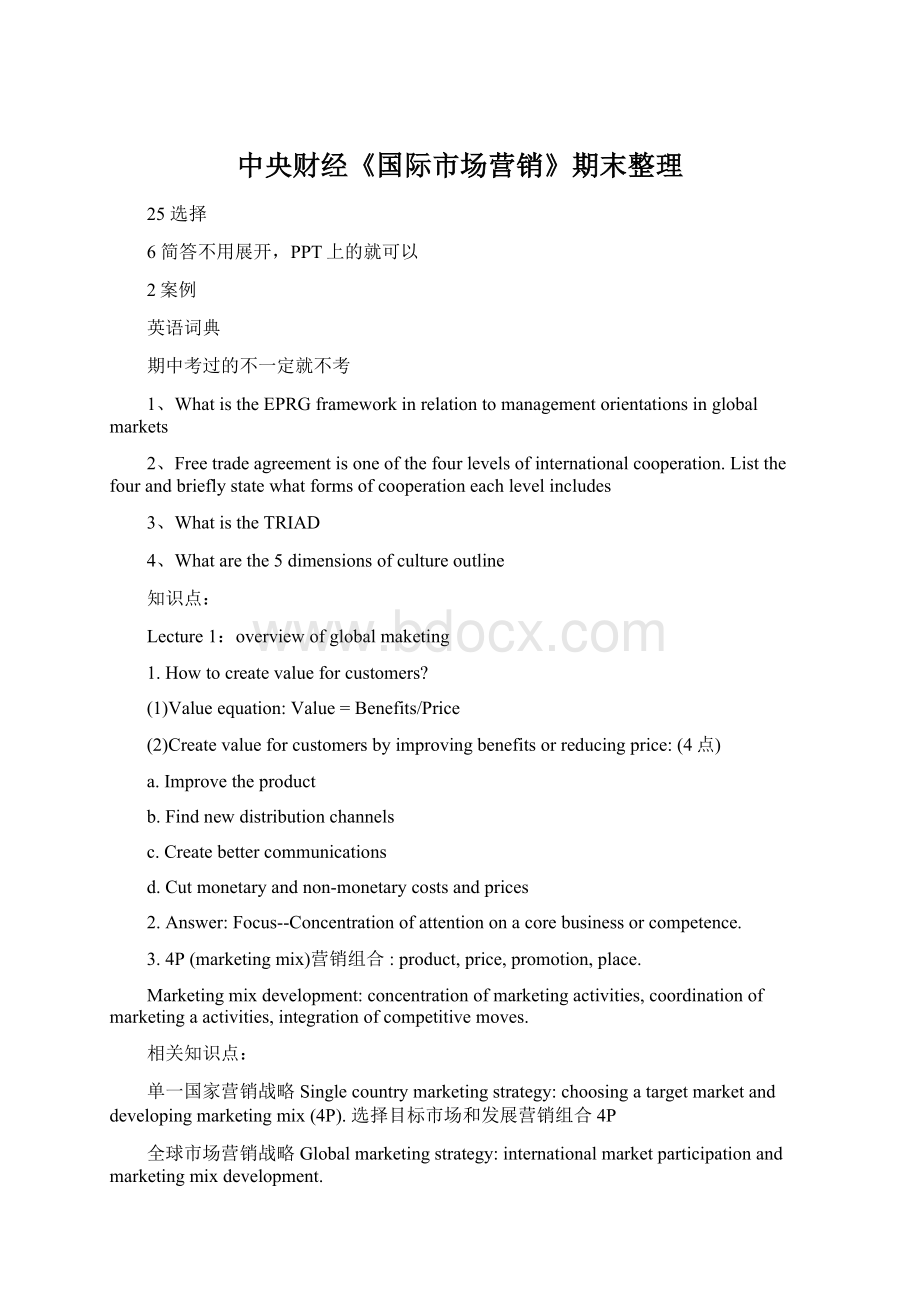中央财经《国际市场营销》期末整理.docx
《中央财经《国际市场营销》期末整理.docx》由会员分享,可在线阅读,更多相关《中央财经《国际市场营销》期末整理.docx(25页珍藏版)》请在冰豆网上搜索。

中央财经《国际市场营销》期末整理
25选择
6简答不用展开,PPT上的就可以
2案例
英语词典
期中考过的不一定就不考
1、WhatistheEPRGframeworkinrelationtomanagementorientationsinglobalmarkets
2、Freetradeagreementisoneofthefourlevelsofinternationalcooperation.Listthefourandbrieflystatewhatformsofcooperationeachlevelincludes
3、WhatistheTRIAD
4、Whatarethe5dimensionsofcultureoutline
知识点:
Lecture1:
overviewofglobalmaketing
1.Howtocreatevalueforcustomers?
(1)Valueequation:
Value=Benefits/Price
(2)Createvalueforcustomersbyimprovingbenefitsorreducingprice:
(4点)
a.Improvetheproduct
b.Findnewdistributionchannels
c.Createbettercommunications
d.Cutmonetaryandnon-monetarycostsandprices
2.Answer:
Focus--Concentrationofattentiononacorebusinessorcompetence.
3.4P(marketingmix)营销组合:
product,price,promotion,place.
Marketingmixdevelopment:
concentrationofmarketingactivities,coordinationofmarketingaactivities,integrationofcompetitivemoves.
相关知识点:
单一国家营销战略Singlecountrymarketingstrategy:
choosingatargetmarketanddevelopingmarketingmix(4P).选择目标市场和发展营销组合4P
全球市场营销战略Globalmarketingstrategy:
internationalmarketparticipationandmarketingmixdevelopment.
4.Standardizationvs.Adaptation
(1)Globalization(standardization)全球化(标准化)(2点)
a.Developingstandardizedproductsmarketedworldwidewithastandardizedmarketingmix
b.Essenceofmassmarketing大众市场营销的精髓
(2)Globallocalization(adaptation)全球本土化:
(3点)
a.Mixingstandardizationandcustomizationinawaythatminimizescostswhilemaximizingsatisfaction
b.Essenceofsegmentation市场细分的精髓
c.Thinkglobally,actlocally
全球化的思维,本土化的行动。
5.Managementorientation(EPRGframework)管理导向的EPRG框架
(1)Ethnocentricorientation母国中心导向型(4点)
1.Homecountryissuperiortoothers
2.Seesonlysimilaritiesinothercountries
3.Assumesproductsandpracticesthatsucceedathomewillbesuccessfuleverywhere
4.Leadstoastandardizedorextensionapproach
eg.Nissan’searlydaysofexportingtotheUnitedStates
相关知识:
domesticcompanies,internationalcompanies
(2)PolycentricOrientation多国中心导向型(4点)
1.Eachcountryisunique
2.Eachsubsidiarydevelopsitsownuniquebusinessandmarketingstrategies
3.Oftenreferredtoasmultinational
4.Leadstoalocalizedoradaptationapproachthatassumesproductsmustbeadaptedtolocalmarketconditions
eg.Citicorp
(3)RegiocentricOrientation区域中心导向型(2点)
1.Aregionistherelevantgeographicunit
2.Somecompaniesservemarketsthroughouttheworldbutonaregionalbasis
eg.GM
(4)GeocentricOrientation世界中心导向型(6点)
1.Entireworldisapotentialmarket
2.Strivesforintegratedglobalstrategies
3.Alsoknownasaglobalortransnationalcompany
4.Retainsanassociationwiththeheadquarterscountry
5.Pursuesservingworldmarketsfromasinglecountryorsourcesgloballytofocusonselectcountrymarkets
6.Leadstoacombinationofextensionandadaptationelements
eg.GM,Harley-Davidson(U.S.),Waterford(Ireland),Gap(U.S.)
Lecture2:
theglobaleconomicenvironment
1.Thenewrealities(-WilliamGreider).五个新现实(5点)
1.Capitalmovementshavereplacedtradeasthedrivingforceoftheworldeconomy
2.Productionhasbecomeuncoupledfromemployment
3.Theworldeconomy,notindividualcountries,isthedominatingfactor
4.75-yearstrugglebetweencapitalismandsocialismhasalmostended
5.E-commercediminishestheimportanceofnationalbarriersandforcescompaniestoreevaluatebusinessmodels
2.Economicsystems
3.BRICS金砖五国:
Brazil,Russia,India,andChinaSouthAfrica
India—low-incomecountry
Brazil,China—low-middle-incomecountries
Russia—upper-middle-incomecountry
SouthAfrica-?
4.Stagesofmarketdevelopment市场发展的4个阶段
TheWorldBankhasdefinedfourcategoriesofdevelopmentusingGrossNationalIncome(GNI)asabase.
(1)Low-Incomecountries低收入
GNIpercapitaof$935orless
Characteristics
Limitedindustrialization工业有限
Highpercentageofpopulationinvolvedinfarming高农业人口百分比
Highbirthrates高出生率
Lowliteracyrates低识字率
Heavyrelianceonforeignaid严重依赖国际援助
Politicalinstabilityandunrest动荡局势
ConcentratedinSub-SaharanAfrica集中于撒哈拉以南非洲
IndiaistheonlyBRICScountry
(2)Low-Middle-Incomecountries中低收入
GNIpercapita:
$936to$3,705
Characteristics
Rapidlyexpandingconsumermarkets消费者市场的迅速扩大
Cheaplabor廉价劳动力
Mature,standardized,labor-intensiveindustriesliketextilesandtoys成熟标准的劳动密集型工业,如玩具和纺织品
China、Brazil、SouthAfrica
(3)Upper-Middle-Incomecountries中高收入
GNIpercapita:
$3,706to$11,455
Characteristics
Rapidlyindustrializing,lessagriculturalemployment农业少工业发达
Increasingurbanization城镇化
Risingwages报酬增长
Highliteracyratesandadvancededucation高识字率和高等教育
Lowerwagecoststhanadvancedcountries比发达国家更少的工资成本
Alsocallednewlyindustrializingeconomies(NIEs)新兴工业化经济体
Malaysia,Chile,Venezuela,Hungary,Ecuador
(4)High-Incomecountries高收入
GNIpercapita:
$11,456ormore
Alsoknowasadvanced,developed,industrialized,orpostindustrialcountries先进发达工业化和信息化的
Characteristics
Sustainedeconomicgrowththroughdisciplinedinnovation革新让经济不断增长
Servicesectorismorethan50%ofGNI服务行业占GNI一半
5.MistakenAssumptionsAboutLDCs+examplesINBOOKLDCs的错误假设
(1)Thepoorhavenomoney.
Intheaggregate,thebuyingpowerofpoorcommunitiescanbesubstantial.InruralBangladesh,villagersspendconsiderablesumstousevillagephonesoperatedbylocalentrepreneurs.
(2)Thepoorwillnot“waste”moneyonnon-essentialgoods.
eg.PoorconsumersbuyTVsandgasstovestoimprovetheirlives.
(3)Enteringdevelopingmarketsisfruitlessbecausegoodstherearetoocheaptomakeaprofit.
Poorpeopleoftenpayhigherprices.Thereisanopportunityforefficientcompetitorstorealizeattractivemarginsbyofferingqualityandlowprices.
(4)PeopleinBOP(bottomofthepyramid)countriescannotusetechnology.
Ruralresidentscananddolearntousecellphones,PCs,andotherdevices.
(5)GlobalcompaniesdoingbusinessinBOPcountrieswillbeseenasexploitingthepoor.剥削穷人
Informaleconomiesinmanypoorcountriesarehighlyexploitive.Aglobalcompanycanimproveacountry’sstandardoflivingwhileearningareasonableROI.
6.TheTriad
UnitedStates,WesternEurope,andJapan
Represents75%ofworldincome
ExpandedtriadincludesallofNorthAmericaandthePacificRimandmostofEasternEurope
Globalcompaniesshouldbeequallystrongineachpart
7.Productsaturationlevels产品饱和水平
Thepercentageofpotentialbuyersorhouseholdswhoownaproduct
India:
1%ofpeoplehavetelephones
Autos:
1per20,000Chinese;21per100Poles;49per100EUcitizens
Computers:
1PCper6,000Chinese;11PCsperPoles;34PCsperEUcitizen
Lecture2B:
TheGlobalTradeEnvironment:
RegionalMarketCharacteristicsandPreferentialTradeAgreements
1.GATT、WTO
(1)GATT--GeneralAgreementonTariffsandTrade
Treatyamongnationstopromotetradeamongmembersestablishedin1947
•Handledtradedisputes
•Lackedenforcementpower
•ReplacedbyWorldTradeOrganizationin1995
(2)WTO—WorldTradeOrganization
Forumfortrade-relatednegotiationsamong150members
BasedinGeneva
ServesasdisputemediatorthroughDSB(DisputeSettlementBody)
Hasenforcementpowerandcanimposesanctions
2.PreferentialTradeAgreements(PTA)最惠国贸易协定
Apreferentialtradeagreementisamechanismthatconfersspecialtreatmentonselecttradingpartners.PTAsgivepartnersspecialtreatmentandmaydiscriminateagainstothers.注意比较
(1)FreeTradeArea(FTA)自由贸易区
Twoormorecountriesagreetoabolishtariffsandotherbarrierstotradeamongthemselves
Countriescontinueindependenttradepolicieswithcountriesoutsideagreement
Rulesoforiginrequirementsrestricttransshipmentofgoodsfromthecountrywiththelowesttarifftoanother
(2)CustomsUnion关税同盟
Evolutionoffreetradearea
Includestheeliminationofinternalbarrierstotrade(asinFTA)
ANDestablishescommonexternalbarrierstotrade
Ex:
TheEUandTurkey
(3)CommonMarket共同市场
Includestheeliminationofinternalbarrierstotrade(asinfreetradearea)
ANDestablishescommonexternalbarrierstotrade(asincustomsunion)
ANDallowsforthefreemovementoffactorsofproduction,suchaslabor,capital,andinformation
(4)EconomicUnion经济联盟
Includestheeliminationofinternalbarrierstotrade(asinfreetradearea)
ANDestablishescommonexternalbarrierstotrade(asincustomsunion)
ANDallowsforthefreemovementoffactorsofproduction,suchaslabor,capital,andinformation(asincommonmarket)
ANDcoordinatesandharmonizeseconomicandsocialpolicywithintheunion
Lecture3A:
SocialandCulturalEnvironments
1.Materialandnonmaterialculture.物质和非物质文化
Culture—waysofliving,builtupbyagroupofhumanbeings,thataretransmittedfromonegenerationtoanother
(1)Materialculture--Physicalcomponentorphysicalculture物质的
Clothing、Tools.、Decorativeart.、Bodyadornment.、Homes.
(2)Nonmaterialculture--Subjectiveorabstractculture非物质的
Religion、Perceptions.、Attitudes.、Beliefs、Values.
2.Attitudes,beliefs,values
Attitudes—learnedtendencytorespondinaconsistentwaytoagivenobjectorentity存在本质
Belief—anorganizedpattern模式ofknowledgethatanindividualholdstobetrueabouttheworld
Value—enduring不朽belieforfeelingthataspecificmodeofconductispersonallyorsociallypreferabletoanothermodeofconduct
3.Aesthetics美学
Thesenseofwhatisbeautifulandwhatisnotbeautiful
Whatrepresentsgoodtasteasopposedtotastelessnessorevenobscenity低俗
Visual视觉—embodiedinthecolororshapeofa